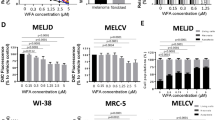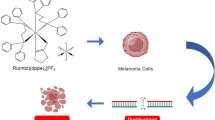Abstract
In this research, ZIF-8 was synthesized and subsequently functionalized by 3-aminopropyltrimethoxysilane (APTES) as a carrier (ZIF-8@APTES) for montelukast sodium (MS). One of the aggressive cancers with a high fatality rate is melanoma. This study aimed to determine the potential cytotoxic effects of montelukast sodium (MS) on the B16F10 murine melanoma cell line as well as the therapeutic effects of MS combined with ZIF-8@APTES as a carrier. B16F10 cells were treated with different doses of ZIF-8@APTES-MS for 24, 48, and 72 h, and then the cytotoxic effect and antioxidant activity of these treatments were studied. Results indicated that after 48 and 72 h, B16F10 cell proliferation was reduced in a dose-dependent manner by MS and/or ZIF-8@APTES-MS. When MS is combined with ZIF-8@APTES, the IC50 concentration is lower than when MS is used alone. Furthermore, receiving 32 μg/ml ZIF-8@APTES-MS after 72 h significantly improved the total antioxidant activity (TAC) of B16F10 cells. In this research, the treatment of melanoma cells with MS and ZIF-8@APTES-MS was investigated.







Similar content being viewed by others
Data availability
The data that support the findings of this study are available from the corresponding author upon reasonable request.
References
Dhanyamraju PK, Patel TN (2022) Melanoma therapeutics: a literature review. J Biomed Res 36(2):77–97
Eddy K, Shah R, Chen S (2021) Decoding Melanoma Development and Progression: Identification of Therapeutic Vulnerabilities. Front Oncol 10:626129
Maio M (2012) Melanoma as a model tumour for immuno-oncology. Ann Oncol 23(Suppl 8):10-viii10- viii14
Leonardi GC et al (2018) Cutaneous melanoma: from pathogenesis to therapy. Int J Oncol 52(4):1071–1080
Sahoo BM et al (2021) Drug repurposing strategy (DRS): emerging approach to identify potential therapeutics for treatment of novel coronavirus infection. Front Mol Biosci 8:628144
Tian W et al (2020) Leukotrienes in tumor-associated inflammation. Front Pharmacol 11:1289
Aigner L et al (2020) The leukotriene receptor antagonist montelukast as a potential COVID-19 therapeutic. Front Mol Biosci 7:610132
El-Sisi AE-DE et al (2015) Role of cysteinyl leukotriene receptor-1 antagonists in treatment of experimentally induced mammary tumor: does montelukast modulate antitumor and immunosuppressant effects of doxorubicin? Toxicol Ind Health 31(11):1024–1036
Slater K et al (2020) High cysteinyl leukotriene receptor 1 expression correlates with poor survival of uveal melanoma patients and cognate antagonist drugs modulate the growth, cancer secretome, and metabolism of uveal melanoma cells. Cancers (Basel) 12(10):2950
Zhu L et al (2017) Cysteinyl leukotrienes as novel host factors facilitating Cryptococcus neoformans penetration into the brain. Cell Microbiol 19(3):e12661
Piromkraipak P et al (2018) Cysteinyl leukotriene receptor antagonists inhibit migration, invasion, and expression of MMP-2/9 in human glioblastoma. Cell Mol Neurobiol 38:559–573
Tsai M-J et al (2017) Montelukast induces apoptosis-inducing factor-mediated cell death of lung cancer cells. Int J Mol Sci 18(7):1353
Yurtdaş-Kirimlioğlu G, Görgülü Ş (2019) Design and characterization of montelukast sodium loaded Kollidon® SR nanoparticles and evaluation of release kinetics and cytotoxicity potential. Lat Am J Pharm 38(7):1350–1360
Ferrari M (2005) Cancer nanotechnology: opportunities and challenges. Nat Rev Cancer 5(3):161–171
Alrushaid N et al (2023) Nanotechnology in cancer diagnosis and treatment. Pharmaceutics 15(3):1025
Rabiee N et al (2022) Green metal-organic frameworks (MOFs) for biomedical applications. Microporous Mesoporous Mater 335:111670
Yang J et al (2023) Multifunctional metal-organic framework (MOF)-based nanoplatforms for cancer therapy: from single to combination therapy. Theranostics 13(1):295
Raptopoulou CP (2021) Metal-organic frameworks: Synthetic methods and potential applications. Materials 14(2):310
Wang Q et al (2020) Synthesis and modification of ZIF-8 and its application in drug delivery and tumor therapy. RSC Adv 10(62):37600–37620
Ke Q et al (2023) Sulfonated vitamin K3 mediated bimetallic metal-organic framework for multistage augmented cancer therapy. J Colloid Interface Sci 654:224–234
Shi L et al (2020) In situ biomimetic mineralization on ZIF-8 for smart drug delivery. ACS Biomater Sci Eng 6(8):4595–4603
Wang H et al (2019) One-pot synthesis of poly (ethylene glycol) modified zeolitic imidazolate framework-8 nanoparticles: size control, surface modification and drug encapsulation. Colloids Surf, A 568:224–230
Zhou Z et al (2023) Pore space partition approach of ZIF-8 for pH responsive codelivery of ursolic acid and 5-fluorouracil. ACS Mater Lett 5(2):466–472
Feng S et al (2021) Zeolitic imidazolate framework-8 (ZIF-8) for drug delivery: a critical review. Front Chem Sci Eng 15(2):221–237
Ding B et al (2023) ZIF-8 Nanoparticles evoke pyroptosis for high-efficiency cancer immunotherapy. Angew Chem 135(10):e202215307
Vasconcelos IB et al (2012) Cytotoxicity and slow release of the anti-cancer drug doxorubicin from ZIF-8. RSC Adv 2(25):9437–9442
Ettlinger R et al (2019) Zeolitic imidazolate framework-8 as pH-Sensitive nanocarrier for “arsenic trioxide” drug delivery. Chem-A Eur J 25(57):13189–13196
Abdi J et al (2017) Synthesis of amine-modified zeolitic imidazolate framework-8, ultrasound-assisted dye removal and modeling. Ultrason Sonochem 39:550–564
Chen Y, Zhang J, Wei S (2023) Montelukast inhibits lung cancer cell migration by suppressing cysteinyl leukotriene receptor 1 expression in vitro. Curr Pharm Biotechnol 24(10):1335–1342
Tang C et al (2018) Montelukast inhibits hypoxia inducible factor-1α translation in prostate cancer cells. Cancer Biol Ther 19(8):715–721
Kani SNM, Samadi-Maybodi A, Najafzadehvarzi H (2023) Functionalized ZIF-8 with aminopropyltrimethoxysilane as montelukast sodium carrier for medical application. Chem Select 8(37):e202302774
Deria P et al (2014) Beyond post-synthesis modification: evolution of metal–organic frameworks via building block replacement. Chem Soc Rev 43(16):5896–5912
Spitsyna AS et al (2022) Stability of ZIF-8 nanoparticles in most common cell culture media. Molecules 27(10):3240
Samadi-Maybodi A, Sedighi-Pashaki E (2021) Comprehensive study of loading and release of sodium valproate drug molecule from functionalized SBA-15 with aminopropyl groups through Co-condensation modification method. Mater Chem Phys 257:123622
Velásquez-Hernández MD (2019) Degradation of ZIF-8 in phosphate buffered saline media. Cryst Eng Comm 21(31):4538–4544
Luzuriaga MA et al (2019) ZIF-8 degrades in cell media, serum, and some—but not all—common laboratory buffers. Supramol Chem 31(8):485–490
Tanum J et al (2022) Generation of zinc ion-rich surface via in situ growth of ZIF-8 particle: Microorganism immobilization onto fabric surface for prohibit hospital-acquired infection. Chem Eng J 446:137054
Amedi HR, Aghajani M (2017) Aminosilane-functionalized ZIF-8/PEBA mixed matrix membrane for gas separation application. Microporous Mesoporous Mater 247:124–135
Zhang W et al (2021) Intelligent dual responsive modified ZIF-8 nanoparticles for diagnosis and treatment of osteoarthritis. Mater Des 209:109964
Bi J et al (2018) Synthesis of folic acid-modified DOX@ ZIF-8 nanoparticles for targeted therapy of liver cancer. J Nanomater. https://doi.org/10.1155/2018/1357812
Hoop M et al (2018) Biocompatibility characteristics of the metal organic framework ZIF-8 for therapeutical applications. Appl Mater Today 11:13–21
Patil-Gadhe A, Pokharkar V (2014) Montelukast-loaded nanostructured lipid carriers: part I oral bioavailability improvement. Eur J Pharm Biopharm 88(1):160–168
Becker AL, Indra AK (2023) Oxidative stress in melanoma: beneficial antioxidant and pro-oxidant therapeutic strategies. Cancers 15(11):3038
Obrador E et al (2019) Oxidative stress and antioxidants in the pathophysiology of malignant melanoma. Biol Chem 400(5):589–612
Cannavò SP et al (2019) The role of oxidative stress in the biology of melanoma: a systematic review. Pathol Res Pract 215(1):21–28
Khalil I et al (2019) Nanoantioxidants: recent trends in antioxidant delivery applications. Antioxidants 9(1):24
He L et al (2020) Highly bioactive zeolitic imidazolate framework-8–capped nanotherapeutics for efficient reversal of reperfusion-induced injury in ischemic stroke. Sci Adv 6(12):eaay9751
Dengiz GO et al (2007) Gastroprotective and antioxidant effects of montelukast on indomethacin-induced gastric ulcer in rats. J Pharmacol Sci 105(1):94–102
Khodir AE et al (2014) Montelukast reduces sepsis-induced lung and renal injury in rats. Can J Physiol Pharmacol 92(10):839–847
Tortolini C et al (2018) Metal oxide nanoparticle based electrochemical sensor for total antioxidant capacity (TAC) detection in wine samples. Biosensors 8(4):108
Acknowledgements
The authors are grateful for the support of the Research Council of Mazandaran University, Iran.
Author information
Authors and Affiliations
Contributions
ASM, SNMK and HN contributed to study concept and design and development of the protocol and participated in designing the evaluation; ASM and SNMK contributed to analysis and interpretation of data and critically revised the manuscript for important intellectual content; and SNMK drafted the manuscript and contributed to statistical analysis. All authors read and approved the final manuscript.
Corresponding author
Ethics declarations
Conflict of interest
The authors declare no conflict of interest.
Ethical approval
Not applicable.
Additional information
Handling Editor: Annela M. Seddon.
Publisher's Note
Springer Nature remains neutral with regard to jurisdictional claims in published maps and institutional affiliations.
Rights and permissions
Springer Nature or its licensor (e.g. a society or other partner) holds exclusive rights to this article under a publishing agreement with the author(s) or other rightsholder(s); author self-archiving of the accepted manuscript version of this article is solely governed by the terms of such publishing agreement and applicable law.
About this article
Cite this article
Kani, S.N.M., Samadi-Maybodi, A. & Najafzadehvarzi, H. Cytotoxicity of ZIF-8@APTES-MS on murine melanoma cells. J Mater Sci 59, 3959–3969 (2024). https://doi.org/10.1007/s10853-023-09214-8
Received:
Accepted:
Published:
Issue Date:
DOI: https://doi.org/10.1007/s10853-023-09214-8




